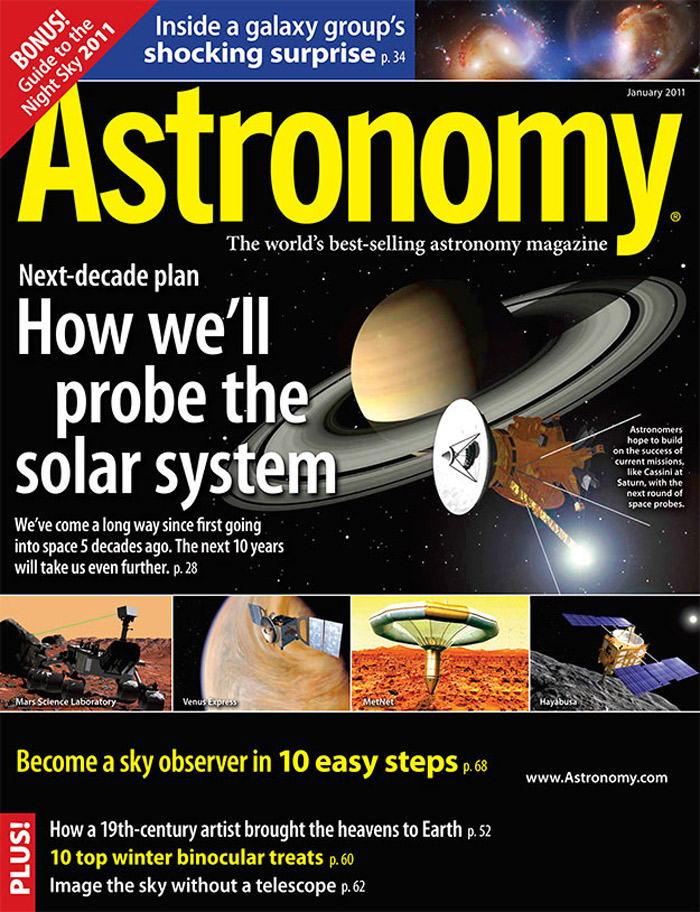
Key Takeaways:
WAUKESHA, Wis. — Much has changed since scientists sent the first probes into space to explore our solar system a half-century ago. No longer are missions episodic, planetary visits brief, or trajectories one way. And the forecast of unmanned missions for the next 10 years looks even more promising, with almost every planet in our neighborhood accounted for. But previewing the coming decade’s spacecraft fleet is challenging — financing is unpredictable, the scope of destinations wide, and the cast of players grand. So we can rest assured that a number of surprises await us before 2020 in our quest to understand the solar system.
In “How we’ll probe the solar system,” author James Oberg outlines which missions look most promising in the coming years, from those already in flight to scheduled near-term launches. Scientists plan to explore in-depth five major planets, two dwarf planets, asteroids, comets, and the Moon. As this occurs, a wave of new technology will become the norm.“The next 10 years will witness more than a mere expansion of interplanetary traffic,” Oberg writes. “The very nature of the traffic will change, as permanence and round-trip missions come to dominate. What now seems surprising … will become the norm by 2020.”To learn more about current and planned missions for the next decade and what scientists hope to study, pick up the January issue of Astronomy, on newsstands November 30.
“A shocking surprise in Stephan’s Quintet”
In 2008, scientists made an unexpected find while studying Stephan’s Quintet, a collection of five galaxies seen close together in the constellation Pegasus: peculiar widespread infrared emission, as well as a bridge of material extending between two of the galaxy group members. In “A shocking surprise in Stephan’s Quintet,” scientists Philip Appleton and Michelle Cluver take readers on the journey to understand this unexpected radiation and the curiosity of its cause — molecular hydrogen.
“Become an observer in 10 simple steps”
There’s a common lament uttered by people who are interested in astronomy but never make it into the hobby: “I don’t know where to start.” Senior Editor Michael E. Bakich makes it easy in “Become an observer in 10 simple steps,” where he lays out a plan similar to the one he used to get into astronomy. Start by learning the sky in a general sense, and pretty soon you’ll be observing everything the cosmos has to offer.
“2011 Guide to the Night Sky”
Astronomy’s “2011 Guide to the Night Sky” is a four-page bonus supplement to the January issue you’ll find invaluable during your next 12 months of observing. It includes a chart of the lunar phases, observing summaries for some of the major solar system targets, and a full-page graphic showing when all the planets will be visible in the sky throughout 2011. A center spread includes four maps depicting the night sky each season, as well as descriptions of numerous deep-sky highlights during that time.
Also in the January 2011 Astronomy
- “How an artist brought the heavens to Earth” — Before computers, advanced telescopes, or even film cameras, Étienne Léopold Trouvelot’s drawings shaped how the public saw the heavens.
- “10 top winter binocular treats” — You don’t need a telescope to observe these cold weather wonders.
- “Shoot the sky without a telescope” — These simple techniques will help you capture great pictures with just a camera on a tripod.
- “The new Dobsonian revolution” — The simplest telescope undergoes a high-tech redesign.
- “The Sky this Month” — Exclusive pullout star charts will guide you through January’s night sky.
- The January issue of Astronomy also includes Astro News, Bob Berman’s Strange Universe, Glenn Chaple’s Observing Basics, David Levy’s Evening Stars, Stephen James O’Meara’s Secret Sky, Tony Hallas’ Imaging the Cosmos, Ask Astro, Deep-sky Showcase, The Cosmic Grid, New Products, and Reader Gallery.








